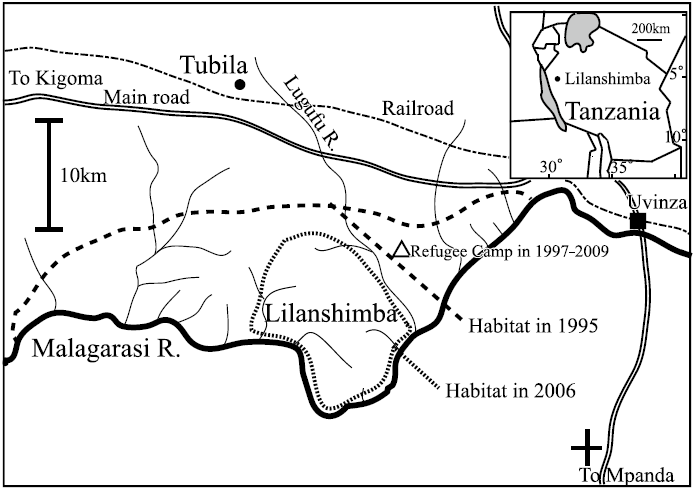|
<NOTE>
A Chimpanzee Bed Found at Tubila, 20 km from Lilanshimba Habitat
Hideshi Ogawa1, Midori Yoshikawa2,3 & Mapinduzi Mbalamwezi
1 Chukyo University, Japan 2 United Graduate School of Agricultural Science, Tokyo University of Agriculture and Technology, Japan 3 JSPS Research fellow INTRODUCTION Some unit-groups (communities) of chimpanzees (Pan troglodytes) have huge home ranges in the savanna woodland area of western Tanzania1. However, it is difficult to follow non-habituated chimpanzees to confirm their home range. Although chimpanzee beds show the distribution of chimpanzee habitats, researchers cannot estimate the home range of each unit-group based on the location of beds when the home ranges of several unit-groups overlap, unless, for example, the identities of the beds are examined by DNA analyses. If the unit-group has no neighboring group, however, researchers can use beds to estimate the home range of that unit group. Here, we report the discovery of a chimpanzee bed at Tubila, which was considered to be outside chimpanzee habitat, and discuss home range use and possible gene flow of chimpanzees in the savanna woodland area. RESULTS Tubila is located in the Mkuti Forest Reserve (05°01′S, 30°06′E), 25 km north of the Malagarasi River, and 30 km southeast of Kigoma City (Figure 1). There are several patchy evergreen forests surrounded by deciduous miombo woodlands in Tubila. Anubis baboons (Papio anubis) and common duikers (Sylvicapra grimmia) inhabit Tubila, but there was no previous information indicating that chimpanzees inhabited the area before our finding. 
Figure 1. Locations of Tubila and Lilanshimba. When M. Mbalamwezi, a local research assistant for our savanna chimpanzee research project, passed Tubila on 25 February, 2008, in the rainy season, he found a chimpanzee bed in one of the evergreen forests. The bed was at a height of approximately 20 m, and was made in a 30 m Julbernardia unijugata or Monopetalanthus richardsiae tree (local name, Kabanba). The bed site was 500 m north of the main road connecting the cities of Kigoma and Uvinza. Most leaves in the bed were still green, indicating that only several weeks had passed since the bed was made. M. M. did not find any other chimpanzee traces such as hair or footprints around the bed. M. M. and A. Alufuled, another research assistant, visited the site together on 10 March, 2009, and found that the framework of the bed remained in place. M. M. visited the place once again in May 2010 and found that the bed was gone. Furthermore, on 31 July 2010, M. M., H. Ogawa, and M. Yoshikawa visited the location and walked 4.5 km in and around the forest, but did not find any traces of chimpanzees. DISCUSSION The nearest chimpanzee habitat to Tubila is Lilanshimba, which is 20 km south of Tubila2,3. One of the chimpanzees from the Lilanshimba population might have temporarily come to Tubila and stayed one night there. It is possible that chimpanzees safely moved from Lilanshimba to Tubila, because riverine and patchy evergreen forests and savanna woodlands are distributed in the area alongside small villages and cultivated fields. The next nearest chimpanzee habitats are Kwitanga and Gombe National Park4,5. However, Kwitanga is 45 km north and Gombe is 60 km northwest of Tubila. Because the area between them is occupied by villages, cultivated fields, and bare hills now, it seems very difficult for Kwitanga and Gombe chimpanzees to cross that area. There was no information to indicate that a chimpanzee had been recently captured and released near Tubila. Therefore, the chimpanzee who made the bed at Tubila was most likely to be a member of the Lilanshimba population. In the Lilanshimba area, 32–45 chimpanzees in one or two unit-groups inhabited a 316 km2 area (0.10–0.14 bed-building individuals/km2) in 19952. However, Congolese refugee camps were built there in 1997, and their activities seriously damaged the chimpanzees and their habitat. As a result, only a few chimpanzees remained in a 175 km2 area (0.02 individuals/km2) in 20063. Although H. O. and M. Y. confirmed that chimpanzees were surviving in the area when chimpanzees were heard during a stay between 16 and 20 August, 2007, the local population in Lilanshimba was facing extermination. After the Congolese refugees left the refugee camps in 2009, however, local people near Lilanshimba said that the original vegetation gradually began to recover, and some wild animals returned to the area. If the hypothesis that a Lilanshimba chimpanzee made its way to Tubila is correct, the chimpanzee moved at least 15 km from the north edge of the original habitat. In addition, the 25 km distance between the bed and the south edge of the original home range shows that chimpanzees may have a huge annual home range in the savanna woodland area. One of the longest records of one day movement by a chimpanzee is 10.7 km at Gombe5. The chimpanzee at Tubila may not have walked 15 km in one day, as there are many places in which a chimpanzee could have slept between Lilanshimba and Tubila. Food scarcity might have promoted the long-range movement, because deforestation by Congolese refugees reduced feeding trees, and because fewer ripe fruits occur during the rainy season than during the dry season (Yoshikawa, unpublished data). It is not surprising that only one bed was found, because chimpanzees disperse into small parties during the rainy season in this area. On the other hand, however, the chimpanzee at Tubila might have been in progress of possible transfer to another unit-group, although sex of the chimpanzee is unknown. Such long-distance dispersal may still be occurring, potentially producing gene flow between isolated populations in the savanna woodland area, western Tanzania. ACKNOWLEDGMENTS We thank Mr. Alex Alufuled and other local research assistants, Dr. G. Idani, Dr. M. Koganezawa, Mr. T. Nemoto, and Dr. J. Moore. This study was permitted by COSTECH and TAWIRI, and financially supported by a Grant-in-Aid for Scientific Research (C) from MEXT (22570223) and AS-HOPE. REFERENCES
Back to Contents |